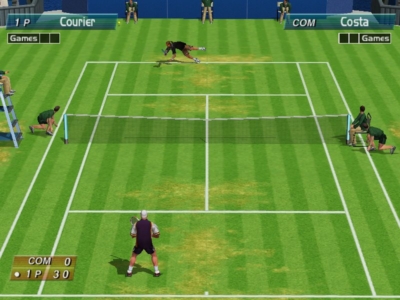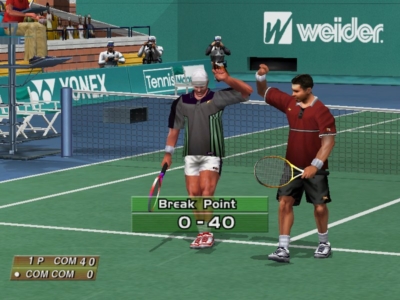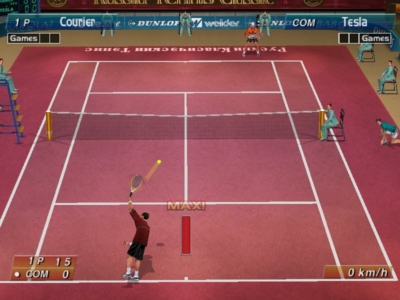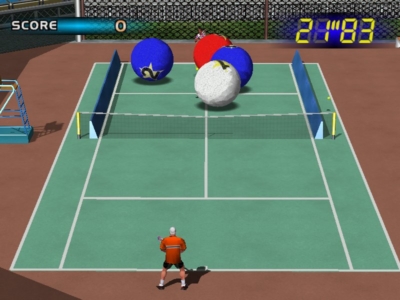
Virtua Tennis
Written by: Rik
Date posted: February 5, 2007
- Genre: Sport
- Developed by: Sega
- Published by: Empire Interactive
- Year released: 2002
- Our score: 7
Though it may come as a surprise to non-sports fans who are regularly confronted by huge stockpiles of the latest version of FIFA every time they go to their local games emporium, when it comes to sports games these days, there isn’t really a great deal of variety on offer. Even the once-saturated football game market has now been reduced to an annual face-off between the latest offerings from Konami and EA. If you happen to be a fan of almost any other sport (apart from US sports, more than adequately catered for by the EA Sports behemoth), it’s more a case of taking what you can get, with titles of variable quality half-heartedly cranked out every couple of years or so to little or no fanfare.
In terms of tennis games on the PC, there’s been almost nothing since 2002, the year this game hit the shelves. Long heralded by console fans as the last word in tennis games, it was a Dreamcast-only release until that machine’s fate was sealed and Sega decided to make a bit of cash by allowing it to be ported to the PC. While it may not readily qualify as an oldie, it’s been around for a number of years now, with the original game first released on console in 2000, having featured in arcades the previous year. Above all, it (just) passes our test of being playable on a five-year old machine, even if it does look reasonably super-duper when compared to some of the ageing fare reviewed elsewhere on FFG.
The first thing to be said of Virtua Tennis is that it’s very obviously a) an arcade game and b) ported from a console. Bright colours assault the eyes as soon as the title screen appears, accompanied by a deep-voiced man booming ‘VIRTUA TENNIS!’ at you with an unsettling amount of enthusiasm. It’s also hardly the most fully-featured of games, boasting only three game modes: Arcade, Exhibition and World Tour, and seven real-world players – all of which, it has to be said, are male (in other words, there’s absolutely no acknowledgement of women’s tennis anywhere in the game).
In single-player mode at least, the most mileage to be gained is from the World Tour mode, with the Arcade game essentially a Streetfighter II-style battle against increasingly more skilful opponents and Exhibition mode allowing you the chance to play a single match against a computer opponent. World Tour offers considerably more content: you select your tennis pro from those available and go about working your way up the world rankings by achieving victory in a variety of singles and doubles matches, as well as earning extra cash by completing additional training exercises. This cash can then be used to ‘unlock’ extra features for use elsewhere in the game, such as snazzy new shirts for your players, extra opponents (all unlicensed, sadly) and additional venues.

If you’re badly positioned, you can still make a desperate dive. Don’t expect to hit the ball well though.
It’s hardly a comprehensive representation of slogging your guts out on the men’s tour, with each ‘tournament’ consisting of only a handful of games at the most and your change in world ranking only goes one way – up – as defeats are never registered, the game instead offering you the chance to try again or quit. While there is certainly plenty of mileage in this mode (the occasionally-preposterous sub-games offering a welcome change from the matches themselves) the arcadey approach may not be to everyone’s liking.
To an extent, the same could be said for the game itself. Though the on-court action has been acclaimed from all corners, some may dispute its reputation as the most comprehensive and realistic tennis game available. For a start, you can’t play more than one set, even in Exhibition mode, while serving aces, a staple of the men’s game, is a noticeably rare occurrence. The frenetic pace of each point, meanwhile, occasionally verges on the ridiculous, especially with both players at the net, thundering close range volleys at each other that no earthly being could possibly react to in time.
These gripes aside, there’s still plenty to admire about the way Virtua Tennis plays. Most of the shots in the game are executed with just one button, allowing the player to concentrate on shot placement and beating opponents rather than grappling with overly complicated controls. With the basics overcome relatively easily, the focus switches to actually trying to play good tennis and meet the challenge of overcoming some pretty competent AI players. The shortened matches, meanwhile, ensure that the intensity level remains high, with each and every point fiercely contested.
At times, it’s impressive stuff. In close matches against the top players, things can get so tight that it becomes possible to identify one single moment where the match was won and lost, and, depending on how tight a reign you keep on your temper, you’ll soon be slapping your greasy little fingers against the joypad buttons for another go or wanting to hurl the bloody thing out of the window. Either way, it’s a very involving game, and it soon becomes apparent that its reputation as a top sports title is well deserved.
However, without a more comprehensive career mode to fall back on, the single-player game has quite a limited lifespan, with longevity severely limited by the fact that there’s literally nowhere to go once you’ve reached the top. Where most sports games allow the successful player to carry on playing to their heart’s content, beat the toughest opponent here and that’s it – game over.

Doubles features quite heavily in the World Tour mode. Luckily, your AI partner is surprisingly adept.
There’s also the question of whether you should have the option to play more than one set and participate more fully in tournaments. In some respects it feels like a major omission, but then people seem happy enough to have 90 minutes of football match reduced to ten minutes of screen time in games – why shouldn’t it be the same with tennis and other sports? When you consider the amount of time a five set match would take up (not to mention a five-day test in cricket) it’s easy to see the benefit of Virtua Tennis‘s approach.
Nevertheless, there’s a nagging feeling that something’s missing here, and despite its many strong points, there’s very little to keep you coming back unless you happen to have a willing human opponent available. Throw in the fact that it’s a sloppy port with some serious frame-rate and other graphical glitches (you could almost be playing it on a Dreamcast emulator someone cooked up in their spare time) and it all adds up to a slightly disappointing FFG score. Bearing in mind the lack of choice on offer, though, it’s definitely still worth a look – especially at the right price.




 Posts
Posts